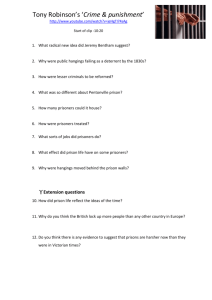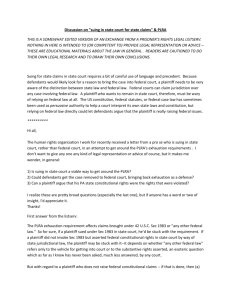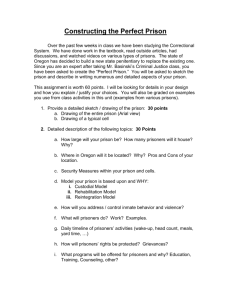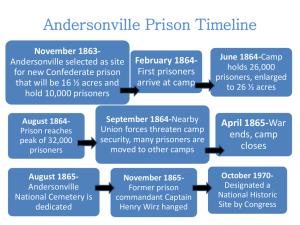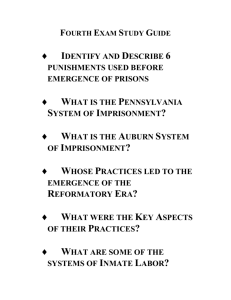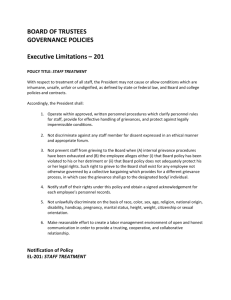Preserving the Rule of Law in America's Prisons
advertisement
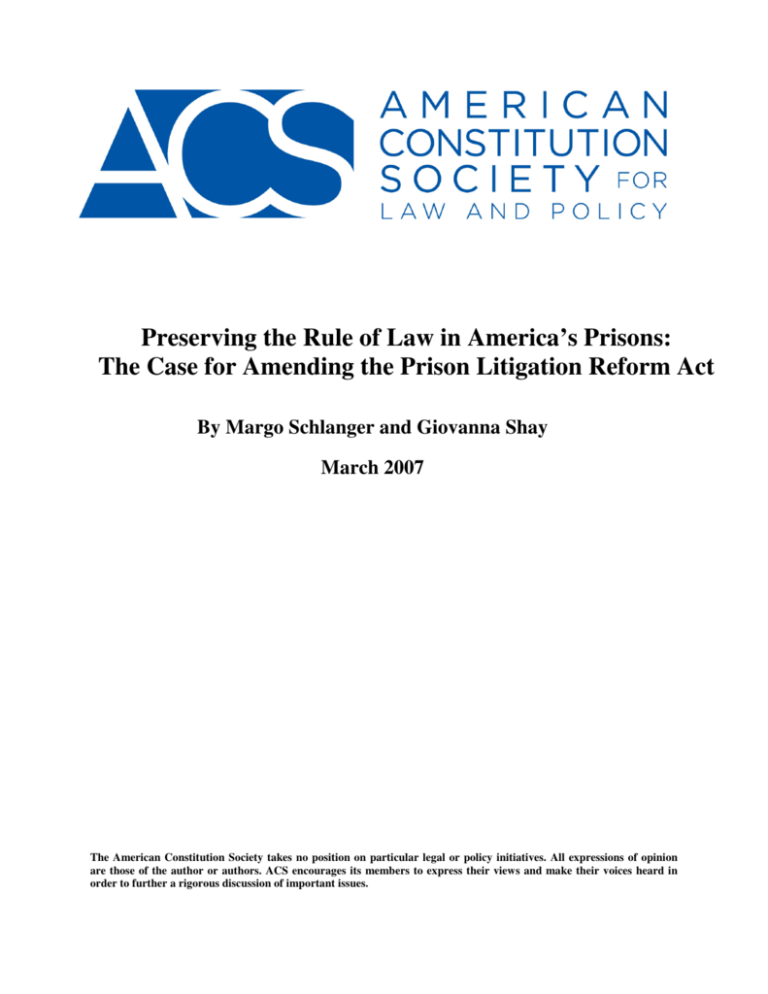
Preserving the Rule of Law in America’s Prisons: The Case for Amending the Prison Litigation Reform Act By Margo Schlanger and Giovanna Shay March 2007 The American Constitution Society takes no position on particular legal or policy initiatives. All expressions of opinion are those of the author or authors. ACS encourages its members to express their views and make their voices heard in order to further a rigorous discussion of important issues. Preserving the Rule of Law in America’s Prisons: The Case for Amending the Prison Litigation Reform Act By Margo Schlanger* and Giovanna Shay** Congress passed the Prison Litigation Reform Act (PLRA) in 1996, as part of an emergency appropriations bill.1 It was aimed at two perceived problems: first, too many frivolous lawsuits by prisoners, and second, too many intrusive consent decrees governing prison conditions.2 Though the PLRA effected sweeping changes in a major area of law and litigation, it was the subject of just one congressional hearing3 and extremely limited debate. Because some provisions were drafted sloppily, courts have struggled to implement the statute and it has been the subject of six Supreme Court decisions resolving competing interpretations by the federal Courts of Appeals.4 The decade since the PLRA’s enactment has seen more troublesome problems than this plentiful legal wrangling, however. It has become clear that the PLRA is undermining the rule of law in America’s prisons, even as those prisons have grown in their importance—both because of the increasing incarcerated population5 and the sharpening international focus on American treatment of prisoners, both domestically and abroad. We do not quarrel with the observation that prisoner lawsuits in federal court are numerous and often frivolous, and that this poses real management challenges both for courts * Professor of Law, Washington University in St. Louis. Prof. Schlanger is a member of the Commission on Safety and Abuse in America’s Prisons, and represented the ACLU and prisoners rights organizations in Woodford v. Ngo, a Supreme Court case interpreting the PLRA. ** Robert M. Cover Clinical Teaching Fellow, Yale Law School; Assistant Professor, Western New England College School of Law beginning in August 2007. Ms. Shay was counsel for amicus curiae Jerome N. Frank Legal Services Organization of the Yale Law School in Woodford v. Ngo and Jones v. Bock, two cases interpreting the PLRA. Both authors are members of the coalition of advocates and scholars known as “SAVE” (Stop Abuse and Violence Everywhere) which is seeking reform of the Prison Litigation Reform Act. For more information, see http://www.savecoalition.org. 1 Pub. L. No. 104-134, §§ 801–810, 110 Stat. 1321, 1321-66 to -77 (Apr. 26, 1996) (codified at 11 U.S.C. § 523; 18 U.S.C. §§ 3624, 3626; 28 U.S.C. §§ 1346, 1915, 1915A; 42 U.S.C. §§ 1997–1997h). (The PLRA was part of the Omnibus Consolidated Rescissions and Appropriations Act of 1996 that ended the 1996 federal government budget standoff.) 2 See Margo Schlanger, Inmate Litigation, 116 HARV. L. REV. 1555 (2003), Margo Schlanger, Civil Rights Injunctions Over Time: A Case Study of Jail and Prison Court Orders, 81 N.Y.U. L. REV. 550 (2006) (discussing first and second problems, respectively). 3 Taking Back Our Streets Act of 1995: Hearing on H.R. 3 Before the H. Comm. on the Judiciary, Subcomm. on Crime, 104th Cong. (1995). 4 Martin v. Hadix, 527 U.S. 343 (1999); Miller v. French, 530 U.S. 327 (2000); Booth v. Churner, 532 U.S. 731 (2001); Porter v. Nussle, 534 U.S. 516 (2002); Woodford v. Ngo, 126 S. Ct. 2378 (2006); Jones v. Bock, 127 S. Ct. 910 (2007). See Inmates of Suffolk County Jail v. Rouse et al., 129 F.3d 649, 654 (1st Cir. 1997) (“The PLRA is not a paragon of clarity.”), Cody v. Hillard, 304 F.3d 767, 776 (8th Cir. 2002). 5 See U.S. DEPT. OF JUSTICE OFFICE OF JUSTICE PROGRAMS BUREAU OF JUSTICE STATISTICS, KEY CRIME & JUSTICE FACTS AT A GLANCE: CORRECTIONAL POPULATIONS http://www.ojp.usdoj.gov/bjs/glance/tables/corr2tab.htm (reporting 1.6 million inmates in American jails and prisons in 1995; by 2005, that number had increased by 38 percent, to 2.2 million). 1 and for correctional authorities.6 The PLRA has had a salutary effect on this problem. First, it has drastically shrunk the number of cases filed: prison and jail inmates filed 26 federal cases per thousand inmates in 1995;7 the most current statistic, for 2005, was just 11 cases per thousand inmates, a decline of nearly 60 percent.8 Second, the PLRA even further reduces the burden on correctional officials by requiring courts to dispose of prisoner civil rights cases if they are legally insufficient without even notifying the sued officials that they have been sued.9 But in addition to frivolous or legally insufficient lawsuits, there are, of course, serious cases brought by prisoners: cases involving life-threatening deliberate indifference by authorities to prisoner health and safety; sexual assaults; religious discrimination; retaliation against those who exercise their free speech rights; and so on. When the PLRA was passed, its supporters emphasized, over and over: “[We] do not want to prevent inmates from raising legitimate claims. This legislation will not prevent those claims from being raised. The legislation will, however, go far in preventing inmates from abusing the Federal judicial system.”10 Yet “prevent[ing] inmates from raising legitimate claims” is precisely what the PLRA has done in many instances. If the PLRA were successfully “reduc[ing] the quantity and improv[ing] the quality of prisoner suits,”11 as its supporters intended, one would expect the dramatic decline in filings to be accompanied by a concomitant increase in plaintiffs’ success rates. The evidence is quite the contrary. The shrunken inmate docket is less successful than before the PLRA’s enactment; more cases are dismissed, and fewer settle.12 An important explanation is that constitutionally meritorious cases are now faced with new and often insurmountable obstacles. The resulting harm is not only to the claimants in the particular cases that have been dismissed notwithstanding their constitutional merit. The harm is to the entire system of accountability that ensures that prison and jail officials comply with constitutional mandates. In this paper, we focus on three separate accountability problems created by the PLRA. First, the 6 See Schlanger, Inmate Litigation, supra note 2, at 1575-1627 for full discussion. 7 See U.S. DEPT. OF JUSTICE OFFICE OF JUSTICE PROGRAMS BUREAU OF JUSTICE STATISTICS, supra note 5, ADMINISTRATIVE OFFICE OF THE U.S. COURTS, JUDICIAL BUSINESS OF THE UNITED STATES COURTS 132 (1997) (reporting prisoner petitions in table C-2A), available at http://www.uscourts.gov/judicial_business/c2asep97.pdf. 8 See U.S. DEPT. OF JUSTICE OFFICE OF JUSTICE PROGRAMS BUREAU OF JUSTICE STATISTICS, supra note 5, ADMINISTRATIVE OFFICE OF THE U.S. COURTS, JUDICIAL BUSINESS OF THE UNITED STATES COURTS 166 (2006) (reporting prisoner petitions in table C-2A), available at http://www.uscourts.gov/judbus2006/appendices/c2a.pdf. 9 28 U.S.C. § 1915A(a) (2007). 10 141 Cong. Rec. S14,627 (daily ed. Sept. 29, 1995) (statement of Sen. Hatch) (“The crushing burden of these frivolous suits makes it difficult for the courts to consider meritorious claims.”); see also 141 Cong. Rec. S19,114 (daily ed. Dec. 21, 1995) (statement of Sen. Kyl) (“If we achieve a 50-percent reduction in bogus Federal prisoner claims, we will free up judicial resources for claims with merit by both prisoners and nonprisoners.”), 141 Cong. Rec. S18,136 (daily ed. Dec. 7, 1995) (statement of Sen. Hatch), 141 Cong. Rec. H1480 (daily ed. Feb. 9, 1995) (statement of Rep. Canady) (“These reasonable requirements will not impede meritorious claims by inmates but will greatly discourage claims that are without merit.”). 11 See Porter, 534 U.S. at 524. 12 See Schlanger, Inmate Litigation, supra note 62, at 1644-1664. 2 application of the PLRA’s limitations to juveniles incarcerated in juvenile institutions13 has rendered those institutions largely immune from judicial oversight, because so many young people are not able to follow the complex requirements imposed by the statute, and compliance by their parents or guardians on their behalf has been deemed legally insufficient. Second, the PLRA’s ban on awards of compensatory damages for “mental or emotional injury suffered while in custody without a prior showing of physical injury”14 has obstructed judicial remediation of religious discrimination, coerced sex, and other constitutional violations typically unaccompanied by physical injury, likewise undermining the regulatory regime that is supposed to prevent such abuses. Finally, the PLRA’s provision barring federal lawsuits by inmate plaintiffs who have failed to comply with their prisons’ internal grievance procedures—no matter how onerous, futile, or dangerous such compliance might be for them. This obstructs rather than incentivizes constitutional oversight of prison conditions. It strongly encourages prison authorities to come up with ever higher procedural hurdles in order to foreclose subsequent litigation. As a nation, we are committed to constitutional control of the government’s treatment of even those who have broken society’s rules. Over the past ten years, it has become apparent that the provisions of the PLRA just discussed cast shadows of constitutional immunity, contravening that core commitment. As the blue-ribbon Commission on Safety and Abuse in America’s Prisons (co-chaired by former Attorney General Nicholas de B. Katzenbach and former Court of Appeals Judge John J.Gibbons)15 and the American Bar Association16 have also urged, these provisions must be reformed to preserve the rule of law in America’s prisons and jails. I. Application of the PLRA to Juveniles The PLRA applies by its plain terms to juveniles in juvenile facilities.17 But those facilities were not the sources of the problems the PLRA was intended to solve. Even before the PLRA, juveniles accounted for very little inmate litigation.18 This dearth of litigation is not surprising. As the recent investigation into alleged sexual abuse in the Texas juvenile system reminds us, although incarcerated youth are highly vulnerable to exploitation,19 they generally 13 18 U.S.C. § 3626(g)(5) (2007). 42 U.S.C. § 1997e(e) (2007), 28 U.S.C. § 1346(b)(2) (2007). 15 John J. Gibbons & Nicholas de B. Katzenbach, Confronting Confinement: A Report of the Commission on Safety and Abuse in America’s Prisons 84-87(2006) available at http://www.prisoncommission.org/pdfs/Confronting_Confinement.pdf and at 22 WASH. U. J. L. & POL’Y 385, 502506 (2007); see also http://www.prisoncommission.org/report.asp for related materials. 14 16 See http://www.abanet.org/leadership/2007/midyear/docs/journal/hundredtwob.doc. 17 18 U.S.C. § 3626(g)(5) (2007) (“[T]he term ‘prison’ means any Federal, State, or local facility that incarcerates or detains juveniles or adults accused of, convicted of, sentenced for, or adjudicated delinquent for, violations of criminal law.”). 18 Michael J. Dale, Lawsuits and Public Policy: The Role of Litigation in Correcting Conditions in Juvenile Detention Centers, 32 U.S.F. L. REV. 675, 681 (1998) (As of 1998, “[t]here [were] less than a dozen reported opinions directly involving challenges to conditions in juvenile detention centers.”). 19 Ralph Blumenthal, One Account of Abuse and Fear in Texas Youth Detention, N.Y. TIMES, March 8, 2007, at A19; Ralph Blumenthal, Investigations Multiplying in Juvenile Abuse Scandal, N.Y. TIMES, March 4, 2007 at 1.24. See also HUMAN RIGHTS WATCH & AMERICAN CIVIL LIBERTIES UNION, CUSTODY AND CONTROL: CONDITIONS OF 3 are not in a position to assert their legal rights.20 Juvenile detainees are young, often undereducated, and have very high rates of psychiatric disorders.21 Moreover, youth incarcerated in juvenile facilities generally do not have access to law libraries or other sources of information about the law that might enable them to sue more often. As one court has observed, “[a]s a practical matter, juveniles between the ages of twelve and nineteen, who, on average, are three years behind their expected grade level, would not benefit in any significant respect from a law library, and the provision of such would be a foolish expenditure of funds.”22 As with unincarcerated children, when juveniles do bring lawsuits, or otherwise seek to remedy any problems they face behind bars, it is very often their parents or other caretaking adults who take the lead. It is, after all, a parent’s ordinary role to try to protect her child. But the PLRA’s exhaustion provision stymies parents’ efforts to protect their children, instead holding incarcerated youth to an impossibly high standard of self-reliance. The case of Minix v. Pazera23 is a leading example of the result. In Minix, a young man, S.Z., and his mother, Cathy Minix, filed a civil rights suit for abuse that S.Z. endured while incarcerated as a minor in 2002 and 2003 in Indiana juvenile facilities. While in custody, S.Z. was repeatedly beaten, once with “padlock-laden socks.” After one beating, he suffered a seizure, but no one helped him, and he was beaten again the next day. S.Z. was raped and witnessed another child being sexually assaulted. S.Z. was afraid to report the assaults to staff—and his fear was natural enough in light of the fact that some of the staff were involved in arranging fights between juveniles, or would even “handcuff one juvenile so other juvenile detainees could beat him.” Although S.Z. feared retaliation, Mrs. Minix made what the district court termed “heroic efforts to protect her son.” She spoke with staff, and wrote to the juvenile judges. She attempted to meet with the superintendent of one of the facilities, though she was prevented from doing so by staff. She contacted the Department of Corrections Director and the Governor. Ultimately, because of her efforts, S.Z. was “unexpectedly released on order from the Governor’s office.” Nonetheless, the district court dismissed the Minix family’s federal claims under the PLRA’s exhaustion rule because S.Z. had not himself filed a grievance in the juvenile facility. CONFINEMENT IN NEW YORK’S JUVENILE PRISONS FOR GIRLS (September 2006), available at http://hrw.org/reports/2006/us0906/us0906webwcover.pdf. 20 Staci Semrad, Texas Ranger Tells of Prosecutor’s “Lack of Interest,” N.Y. TIMES, March 9, 2007, at A20. (A sergeant in the Texas Rangers investigating abuses at the West Texas State School in Pyote told a legislative committee that he “saw kids with fear in their eyes – kids who knew they were trapped in an institution that would never respond to their cries for help.” The sergeant said he was unable to convince a local prosecutor to take action.) 21 LOURDES M. ROSADO & RIYA S. SHAH, PROTECTING YOUTH FROM SELF-INCRIMINATION WHEN UNDERGOING SCREENING, ASSESSMENT AND TREATMENT WITHIN THE JUVENILE JUSTICE SYSTEM 5 (2007) (“[S]ome large scale studies suggest that as many as 65%-75% of the youth involved in the juvenile justice system have one or more diagnosable psychiatric disorders.”), available at www.jlc.org/File/publications/protectingyouth.pdf. 22 Alexander S. v. Boyd, 876 F. Supp. 773, 790 (D.S.C. 1995). See also Anna Rapa, Comment: One Brick Too Many: The Prison Litigation Reform Act as a Barrier to Legitimate Juvenile Lawsuits, 23 T.M. COOLEY L. REV. 263, 279 (2006). 23 2005 WL 1799538 (N.D. Ind. 2005). 4 At the time, the Indiana juvenile grievance policy allowed only two business days to file a grievance. Only two months after S.Z.’s suit was dismissed, the Civil Rights Division of the United States Department of Justice concluded an investigation and confirmed that one of the Indiana facilities where S.Z. had been assaulted, the South Bend Juvenile Facility, “fails to adequately protect the juveniles in its care from harm,” and violated the constitutional rights of juveniles in its custody. The federal government further concluded that the grievance system that S.Z. was faulted for not using was “dysfunctional” and “contributes to the State’s failure to ensure a reasonably safe environment.” 24 Incarcerated children and youth do not clog the courts with lawsuits, frivolous or otherwise. Though they are often incapable of compliance with the tight deadlines and complex requirements of internal correctional grievance systems, their lack of capacity should not immunize abusive staff from the accountability that comes with court oversight. II. PLRA Physical Injury Requirement The PLRA provides that inmate plaintiffs may not recover damages for “mental or emotional injury suffered while in custody without a prior showing of physical injury.”25 Given the commitment by the Act’s supporters that constitutionally meritorious suits would not be constrained by its provisions, perhaps the purpose of this provision was the limited one of foreclosing tort actions claiming negligent or intentional infliction of emotional distress unless they resulted in physical injury, which might have otherwise been available to federal prisoners under the Federal Tort Claims Act. (This kind of limitation on such tort causes of action is fairly common under state law.26) The reality is that the impact of the physical injury requirement has been much more sweeping. First, many courts have held that the provision covers all personal injury, including violations of non-physical constitutional rights.27 Proven violations of prisoners’ religious rights, speech rights, and due process rights have all been held non-compensable, and thus placed 24 Letter from Bradley J. Schlozman, Acting Assistant Attorney General, to Mitch Daniels, Governor of the State of Indiana (Sept. 9, 2005), available at http://www.usdoj.gov/crt/split/documents/split_indiana_southbend_juv_findlet_9-9-05.pdf (quotes appear on pages 2, 3, and 7). 25 42 U.S.C. § 1997e(e) (2007). See, e.g., Dale Joseph Gilsinger, Annotation, Recovery Under State Law for Negligent Infliction of Emotional Distress Under Rule of Dillon v. Legg, 68 Cal. 2d 728, 69 Cal. Rptr. 72, 441 P.2d 912 (1968), or Refinements Thereof, 96 A.L.R.5th 107 § 6 (2002) (citing cases from 9 states). 26 27 See, e.g., Thompson v. Carter, 284 F.3d 411, 416-17 (2d Cir. 2002) (no compensation available for violation of due process rights); Allah v. Al-Hafeez, 226 F.3d 247, 250 (3d Cir. 2000) (no compensation available for violation of religious rights); Royal v. Kautzky, 375 F.3d 720, 722-23 (8th Cir. 2004) (no compensation available for retaliation for exercise of free speech rights); Searles v. Van Bebber, 251 F.3d 869, 876 (10th Cir. 2001) (no compensation available for violation of religious rights); Davis v. District of Columbia, 158 F.3d 1342, 1348 (D.C. Cir. 1998) (no compensation available for violation of constitutional privacy rights). But see Cannell v. Lightner, 143 F.3d 1210, 1214-15 (9th Cir. 1997) (stating that PLRA “does not preclude actions for violations of First Amendment rights.”). 5 largely beyond the scope of judicial oversight. For example, in Searles v. Van Bebber,28 the Tenth Circuit concluded that the physical injury requirement barred a suit by a Jewish inmate who alleged a First Amendment violation based on his prison’s refusal to give him kosher food. This result is particularly bizarre in light of Congress’s notable concern for prisoners’ religious freedoms. The Religious Land Use and Institutionalized Persons Act29 passed in 2000, states that “No government shall impose a substantial burden on the religious exercise of a person residing in or confined to an institution,” unless the burden furthers “a compelling governmental interest,” and does so by “the least restrictive means.” Moreover, although the case law is far from uniform, some courts have deemed sexual assault not to constitute a “physical injury” within the meaning of the PLRA. In Hancock v. Payne,30 a number of male prisoners alleged that over several hours, a corrections officer sexually assaulted them. “Plaintiffs claim that they shared contraband with [the officer] and that he made sexual suggestions; fondled their genitalia; sexually battered them by sodomy, and committed other related assaults.” The plaintiffs further complained that the officer “threatened Plaintiffs with lockdown or physical harm should the incident be reported.” The district court granted summary judgment in part to the defendants. One of the grounds for this defense victory was the physical injury requirement. The federal district court said, “the plaintiffs do not make any claim of physical injury beyond the bare allegation of sexual assault.” In other words, in the view of this district court, not even an allegation of coerced sodomy constituted physical injury. Though some other courts have decided the question differently, the Hancock court is not alone in reaching this conclusion.31 As with religious rights, this outcome exists in sharp tension with Congress’s recent efforts to eliminate sexual violence and coercion behind bars by passing the Prison Rape Elimination Act of 2003.32 Finally, in case after case, courts have held even serious physical symptoms insufficient to allow the award of damages because of the PLRA’s physical injury provision.33 In one case, a plaintiff alleged that the defendant correctional officer “punch[ed ] Plaintiff repeatedly in his abdominal area, pushed Plaintiff's head down and repeatedly punched Plaintiff with his right 28 251 F.3d at 872, 876. 29 42 U.S.C. § 2000cc-1(a)(1)-(2) (2007). 30 2006 WL 21751 (S.D. Miss.). 31 See Smith v. Shady, 2006 WL 314514 at *2 (M.D. Pa. 2006) (“ … Plaintiff’s allegations in the complaint concerning Officer Shady grabbing his penis and holding it in her hand do not constitute a physical injury or mental symptoms.”). See generally DEBORAH M. GOLDEN, THE PRISON LITIGATION REFORM ACT – A PROPOSAL FOR CLOSING THE LOOPHOLE FOR RAPISTS (June 2006) available at www.acslaw.org/files/Golden%20%20Rape%20and%20PLRA%20white%20paper.pdf. But see Liner v. Goord, 196 F.3d 132, 135 (2d Cir. 1999) (sexual assault constitutes physical injury within the meaning of the PLRA). 32 42 U.S.C. § 15602 et seq. (2007). 33 See Jarriett v. Wilson, 414 F.3d 634 (6th Cir. 2005) (concluding that inmate confined for twelve hours in “strip cage” in which he could not sit down did not suffer physical injury even though he testified that he had a “bad leg” that swelled “like a grapefruit” and that caused severe pain and cramps); Myers v. Valdez, 2005 WL 3147869 at *2 (N.D. Tex. 2005) (concluding that alleged “pain, numbness in extremities, loss of mobility, lack of sleep, extreme tension in neck and back, extreme rash and discomfort” did not satisfy PLRA physical injury requirement); Mitchell v. Horn, 2005 WL 1060658 at *1 (E.D. Pa. 2005) (reported symptoms including “severe stomach aches, severe headaches, severe dehydration . . . and blurred vision,” suffered by inmate confined in cell allegedly “smeared with human waste and infested with flies” did not constitute physical injury for PLRA purposes). 6 hand in the back of his head, hit Plaintiff on his left ear, placed Plaintiff's head between his legs and grabbed Plaintiff around his waist and picked the Plaintiff up off the ground and dropped Plaintiff on his head.” The plaintiff further alleged that he “sustained bruises on [his] left ear, back of [his] head and swelling to the abdominal area of his body.” Nonetheless, the district court held the claim insufficient under the PLRA’s physical injury provision.34 In another, burns to the plaintiff’s face were deemed insufficient, because those burns had “healed well,” leaving “no lasting effect.”35 The point is that the PLRA has made it far more difficult for prisoners to enforce any non-physical rights—including freedom of religion and freedom of speech—and to seek compensation for any mental rather than physical harm, no matter how intentionally, even torturously, inflicted. (This aspect of the law has, in fact, convinced at least one district court to hold it unconstitutional,36 and others to save the provision from constitutional infirmity by reading it not to bar relief.37) The PLRA has left the availability of compensatory damages for the constitutional violation of coerced sex an open question. It has posed an obstacle to compensation even for physical violence, if the physical component of the injury is deemed insufficiently serious. It has thereby undermined the important norms that such infringements of prisoners’ rights are unacceptable. Just as it contradicts constitutional commitments, the PLRA is simultaneously obstructing Congress’s recent efforts to protect prisoners’ religious liberty, as well as freedom from rape. III. PLRA Exhaustion Provision The PLRA’s exhaustion provision states: “no action shall be brought with respect to prison conditions under section 1983 of this title, or any other Federal law, by a prisoner confined in any jail, prison, or other correctional facility until such administrative remedies as are available are exhausted.”38 The provision appears harmless enough. Who could object, after all, to a regime in which corrections officials are given the first opportunity to respond to and perhaps resolve prisoners’ claims? 34 Borroto v. McDonald, 2006 WL 2789152 (N.D. Fla. 2006). 35 Brown v. Simmons, 2007 WL 654920 (S.D. Tex. 2007). 36 See, e.g., Siggers-El v. Barlow, 433 F.Supp.2d 811 (E.D. Mich. 2006), holding the PLRA’s physical injury provision unconstitutional “to the extent it precludes First Amendment claims such as the one presented in this case” and noting: The Court finds the following hypothetical, set forth in Plaintiff's brief, to be persuasive: [I]magine a sadistic prison guard who tortures inmates by carrying out fake executions-holding an unloaded gun to a prisoner's head and pulling the trigger, or staging a mock execution in a nearby cell, with shots and screams, and a body bag being taken out (within earshot and sight of the target prisoner). The emotional harm could be catastrophic but would be non-compensable. On the other hand, if a guard intentionally pushed a prisoner without cause, and broke his finger, all emotional damages proximately caused by the incident would be permitted. Id. at 816 (case settled prior to decision on appeal). 37 Percival v. Rowley, 2005 WL 2572034 at *2 (W.D. Mich. 2005) (“To allow section 1997e(e) to effectively foreclose a prisoner’s First Amendment action would put that section on shaky constitutional ground.”). 38 42 U.S.C. § 1997e(a) (2007). 7 But what if the administrative remedies are very difficult to access? If the deadlines are very short, for example, or the number of administrative appeals required is very large?39 Or if the requisite form is repeatedly unavailable,40 or the prisoner fears retaliation for use of the grievance system (which often require that prisoners get grievance forms from, or hand them to the very officer whose conduct is the subject of their complaint)?41 What if the grievance system seems not to cover the complaint the prisoner seeks to make?42 Or if he is unable to fill out a grievance because he is in the hospital?43 Beginning six years after the PLRA’s enactment, first some of the Courts of Appeals,44 and finally the Supreme Court,45 held that the PLRA forever bars even meritorious claims from court if an inmate has failed to comply with all of the many technical requirements of the prison or jail grievance system. This means that if prisoners miss deadlines that are often less than fifteen days and in some jurisdictions as short as two to five days,46 a judge cannot consider valid claims of sexual assault, beatings, or racial or religious discrimination. Moreover, the PLRA’s exhaustion requirement has been held to grant constitutional immunity to prison officials based on understandable mistakes by lay people operating under rules that are often far from clear. Wardens and sheriffs routinely refuse to engage inmate grievances because they commit minor technical errors, such as using the incorrect form,47 sending the right documentation to the wrong official,48 failing to name a relevant official in the complaint (even if prison administrators have actual knowledge of that official’s role in the incident),49 or failing to file separate forms for each complaint, even if the interpretation of a single claim as raising two separate complaints is the 39 See Brief for Jerome N. Frank Legal Services Organization of the Yale Law School as Amicus Curiae Supporting Respondent, Woodford v. Ngo, 126 S. Ct. 2378 (2006) (No. 05-416) at 6-13, 2006 WL 304573 at *6-*13 and A1-A7 for a survey of prison and jail grievance policy deadlines. 40 See, e.g., Latham v. Pate, 2007 WL 171792 (W.D. Mich. 2007) (dismissing suit due to tardy exhaustion in case in which inmate alleged beating; inmate maintained that he had been placed in segregation and administrative segregation immediately following assault and that “officers did not provide him with the grievance forms”). 41 See, e.g., Umstead v. McKee, 2005 WL 1189605 (W.D. Mich. 2005) (“it is highly questionable whether threats of retaliation could in any circumstances excuse the failure to exhaust administrative remedies”); Garcia v. Glover, 197 Fed. Appx. 866, 867 (11th Cir. 2006) (refusing to excuse non-exhaustion in case in which inmate alleged that he had been beaten by five guards, despite the fact that prisoner alleged that he feared he would be “killed or shipped out” if he filed an administrative grievance). 42 See, e.g., Marshall v. Knight, 2006 WL 3714713 (N.D. Ind. 2006) (dismissing, for failure to exhaust, plaintiff’s claim that prison officials retaliated against him in classification and disciplinary decisions, even though prison policy dictated that no grievance would be allowed to challenge classification and disciplinary decisions); Benfield v. Rushton, 2007 WL 30287 (D.S.C. 2007) (dismissing suit by prisoner who alleged that he was repeatedly raped by other inmates, due to untimely filing of grievance; prisoner had explained that he “didn’t think rape was a grievable issue”). 43 See, e.g., Washington v. Texas Department of Criminal Justice, 2006 WL 3245741 (S.D. Tex. 2006) (dismissing plaintiff’s claim for failure to file a grievance even though he was hospitalized and medically unable to file during the time allowed by state policy). 44 See Pozo v. McCaughtry, 286 F.3d 1022 (7th Cir. 2002). 45 Woodford, 126 S. Ct. 2378. 46 Woodford, 126 S. Ct. at 2402 (Stevens, J., dissenting). 47 See, e.g., Richardson v. Spurlock, 260 F.3d 495, 499 (5th Cir. 2001). See, e.g., Keys v. Craig, 160 Fed.Appx. 125 (3d Cir. 2005). 48 49 See, e.g., Williams v. Hollibaugh, 2006 WL 59334, at *5-*6 (M.D. Pa. 2006). 8 prison administration’s.50 Each such misstep by a prisoner bars consideration of even an otherwise meritorious civil rights action.51 Far from encouraging correctional officials to handle the sometimes frivolous but sometimes extremely serious complaints of inmates, the PLRA’s exhaustion rule actually provides an incentive to administrators in the state and federal prison systems and the over 3000 county and city jail systems to fashion ever higher procedural hurdles in their grievance processes. After all, the more onerous the grievance rules, the less likely a prison or jail, or staff members, will have to pay damages or be subjected to an injunction in a subsequent lawsuit.52 In fact, even when prison and jail administrators want to resolve a complaint on its merits, the PLRA discourages them from doing so, and therefore actually undermines the very interest in self-governance Congress intended to serve.53 Can anyone reasonably expect a governmental agency to resist this kind of incentive to avoid merits consideration of grievances? The officials in question are a varied group—elected jailers and sheriffs, appointed jail superintendents, professional wardens, politically appointed commissioners. What they all have in common is an understandable interest in avoiding adverse judgments against themselves or their colleagues. Thus by cutting off judicial review based on an inmate’s failure to comply with his prison’s own internal, administrative rules—regardless of the merits of the claim—the PLRA exhaustion requirement undermines external accountability. Still more perversely, it actually undermines internal accountability, as well, by encouraging prisons to come up with high procedural hurdles, and to refuse to consider the merits of serious grievances, in order to best preserve a defense of non-exhaustion. Moreover, courts have been extremely rigorous in their application of the exhaustion requirement, refusing the kinds of exceptions one might have expected given the often more flexible non-prison administrative law precedents. For example, one court recently held that 50 Harper v. Laufenberg, 2005 WL 79009, at *3 (W.D. Wis. 2005). 51 See Giovanna E. Shay & Johanna Kalb, More Stories of Jurisdiction-Stripping and Executive Power: The Supreme Court’s Recent Prison Litigation Reform Act (PLRA) Cases, forthcoming, Cardozo Law Review (2007), available at http://ssrn.com/abstract=968486 (reporting data on how many cases have been dismissed on exhaustion grounds post-Woodford: “In a survey of reported cases citing Woodford, in the cases in which the exhaustion issue was decided, the majority were dismissed entirely for failure to exhaust. All claims raised in the complaint survived the exhaustion analysis in fewer than 15% of reported cases.”). 52 There is evidence that prisons and jails have headed in this direction. For example, in July 2002, in Strong v. David, 297 F.3d 646 (7th Cir. 2002), the Seventh Circuit reversed the district court’s dismissal of a case for failure to exhaust; in rejecting the defendants’ argument that the plaintiff’s grievances were insufficiently specific, the court noted that the Illinois prison grievance rules were silent as to the requisite level of specificity. Less than six months later, the Illinois Department of Corrections proposed new regulations that provided: The grievance shall contain factual details regarding each aspect of the offender’s complaint including what happened, when, where, and the name of each person who is the subject of or who is otherwise involved in the complaint. ILL. ADMIN. CODE tit. 20, § 504.810(b) (2007); see 26 Ill. Reg. 18065, at § 504.810(b) (Dec. 27, 2002) (proposing amendment). 53 In fact, if an agency chooses to entertain an untimely grievance that merits examination, the agency is barred from asserting a failure-to-exhaust defense at later time. Riccardo v. Rausch, 375 F.3d 521, 524 (7th Cir. 2004), cert. denied, 125 S. Ct. 1589 (2005). 9 “The PLRA does not excuse exhaustion for prisoners who are under imminent danger of serious physical injury, much less for those who are afraid to confront their oppressors.”54 A rule requiring administrative exhaustion, and punishing failure to cross every t and dot every i by conferring constitutional immunity for civil rights violations, is simply unsuited for the circumstances of prisons and jails, where physical harm looms so large and prisoners are so ill equipped to comply with legalistic rules. Ideally, grievance systems actually improve agency responsiveness and performance, by helping corrections officials to identify and track complaints and to resolve problems.55 But the PLRA’s grievance provision instead encourages prison and jail officials to use their grievance systems in another way—not to solve problems, but to immunize themselves from future liability. Judicial oversight of prisoners’ civil rights is essential to minimize violations of those rights, but the PLRA’s exhaustion provision arbitrarily places constitutional violations beyond the purview of the courts. It would be relatively simple to achieve the legitimate goal of allowing prison and jail authorities the first chance to solve their own problems, without creating the kinds of problems the PLRA has introduced. The exhaustion provision should not be eliminated, but rather amended, to require simply that prisoners’ claims be presented to corrections officials prior to court filing.56 * * * The PLRA has shrunk the number of court cases initiated by prisoners. In addition, because the statute instructs courts to screen the cases, and send them on to defendant jail and prison officials only if they are not frivolous or legally insufficient, the PLRA has reduced the burden those cases pose prison and jail administrators. These are positive results and achieve the avowed purpose of the statute. But the provisions of the PLRA discussed in this position paper undermine the rule of law, by shielding corrections officials from accountability even in situations in which law violations are clear. As the American correctional system has grown in size and political salience, these statutory missteps hide parts of that system from constitutional review. The PLRA must be reformed to protect the rule of law in America’s prisons and jails. 54 Broom v. Rubitschun, 2006 WL 3344997 (W.D. Mich. 2006). 55 See LYNN S. BRANHAM, ET AL., LIMITING THE BURDENS OF PRO SE INMATE LITIGATION: A TECHNICALASSISTANCE MANUAL FOR COURTS, CORRECTIONAL OFFICIALS, AND ATTORNEYS GENERAL (American Bar Association Criminal Justice Section 1997). 56 For this and other specific proposals relating to the PLRA’s text, see http://www.savecoalition.org. 10
